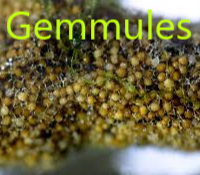
Answer
454.8k+ views
Hint: Gemmules are tough and coated with a dormant cluster of embryonic cells. When many gemmules are formed, the animal body gets disintegrated and thus all the gemmules are liberated out.
Complete answer:
A Gemmule is a type of an internal bud that gets formed in freshwater sponges (Eg: Spongilla).In other words, they are small bud-like masses of cells that are produced asexually and are capable of developing into a new organism. Thus, they are useful in asexual reproduction. Gemmules can not become dry which means they are resistant to desiccation.i.e, becoming dry, freezing, and anoxia (lack of oxygen) and can lie around for long periods.

Gemmule Of Spongilla
Additional Information:
- The endospore that is surrounded by a layer of spicules forms the outer layer of the gemmule. This layer enclosed the gemmule and protected it.
-This layer helps the gemmule to struggle against all other unfavorable environmental conditions and also helps them in growing into an adult sponge.
-Parthenogenesis is a type of reproduction in which without being fertilized by a sperm, an egg can develop into an embryo. Parthenogenesis occurs in several insect species including aphids, bees, and ants.
-Parthenocarpy is a type of reproduction in which artificial or natural induced production of fruits takes place without the fertilization of ovules. Varieties of the pineapple, banana, cucumber, grape, orange, grapefruit, and persimmon exemplify naturally occurring parthenocarpy.
So, the correct answer is, ‘ asexual reproduction’.
Note: - At the bottom of the pond, gemmules lie in a dormant condition, and at the advent of favorable conditions they hatch and develop into new sponges.
-Aphids are members of the superfamily Aphidoidea and are also small sap-sucking insects.
-Although individuals within a species can vary widely in color but can have common names including greenfly and blackfly.
-Parthenocarpy produces seedless fruits.
Complete answer:
A Gemmule is a type of an internal bud that gets formed in freshwater sponges (Eg: Spongilla).In other words, they are small bud-like masses of cells that are produced asexually and are capable of developing into a new organism. Thus, they are useful in asexual reproduction. Gemmules can not become dry which means they are resistant to desiccation.i.e, becoming dry, freezing, and anoxia (lack of oxygen) and can lie around for long periods.

Gemmule Of Spongilla
Additional Information:
- The endospore that is surrounded by a layer of spicules forms the outer layer of the gemmule. This layer enclosed the gemmule and protected it.
-This layer helps the gemmule to struggle against all other unfavorable environmental conditions and also helps them in growing into an adult sponge.
-Parthenogenesis is a type of reproduction in which without being fertilized by a sperm, an egg can develop into an embryo. Parthenogenesis occurs in several insect species including aphids, bees, and ants.
-Parthenocarpy is a type of reproduction in which artificial or natural induced production of fruits takes place without the fertilization of ovules. Varieties of the pineapple, banana, cucumber, grape, orange, grapefruit, and persimmon exemplify naturally occurring parthenocarpy.
So, the correct answer is, ‘ asexual reproduction’.
Note: - At the bottom of the pond, gemmules lie in a dormant condition, and at the advent of favorable conditions they hatch and develop into new sponges.
-Aphids are members of the superfamily Aphidoidea and are also small sap-sucking insects.
-Although individuals within a species can vary widely in color but can have common names including greenfly and blackfly.
-Parthenocarpy produces seedless fruits.
Recently Updated Pages
Who among the following was the religious guru of class 7 social science CBSE

what is the correct chronological order of the following class 10 social science CBSE

Which of the following was not the actual cause for class 10 social science CBSE

Which of the following statements is not correct A class 10 social science CBSE

Which of the following leaders was not present in the class 10 social science CBSE

Garampani Sanctuary is located at A Diphu Assam B Gangtok class 10 social science CBSE

Trending doubts
Write the difference between order and molecularity class 11 maths CBSE

A rainbow has circular shape because A The earth is class 11 physics CBSE

Which are the Top 10 Largest Countries of the World?

Fill the blanks with the suitable prepositions 1 The class 9 english CBSE

How do you graph the function fx 4x class 9 maths CBSE

Give 10 examples for herbs , shrubs , climbers , creepers

What are noble gases Why are they also called inert class 11 chemistry CBSE

The Equation xxx + 2 is Satisfied when x is Equal to Class 10 Maths

Differentiate between calcination and roasting class 11 chemistry CBSE




